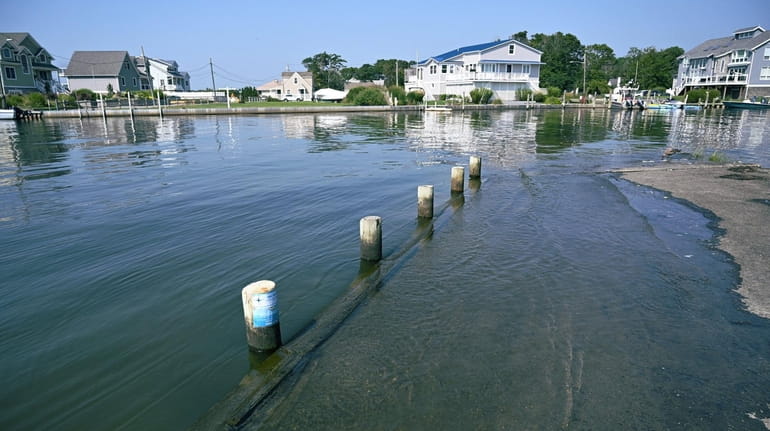Tropical Storm Henri likely fouled some bodies of water, scientists say

The waters of Moriches Bay near some homes in Moriches on Thursday. Hurricane Henri delivered copious amounts of rain and runoff to surface waters. Credit: John Roca
Tropical Storm Henri caused surprisingly widespread bacterial contamination in Long Island's waters and thus likely fueled algae blooms, though the storm's winds and rain were far less destructive for Long Island than initially feared, scientists said.
This week’s samples from 29 bodies of water on the North and South shores revealed "A high level of fecal bacteria that was just ubiquitous," said Christopher Gobler, endowed chair of coastal ecology and conservation and principal investigator with the Gobler Laboratory at Stony Brook University.
The water quality in a mere four samples achieved a "Good" rating, in Mount Sinai Harbor, South Oyster Bay, and the inlets of Shinnecock and Mattituck.
The rest of the samples all were rated fair or poor, due to low amounts of oxygen, or fecal contamination from animals and people, mainly from nearby sources.
Swimming in bacteria-laced water can cause gastrointestinal illness, and infections of the eyes, ears, nose, and throat. As a precaution, some Long Island at-risk beaches are shut after storms or until tests reveal levels of bacteria have fallen.
Gobler also checks for dissolved oxygen, which can kill marine life if it falls too low. Algae blooms can worsen the problem after they die and decay on the bottom. Henri broke up some algae blooms.
The eastern Great South Bay and the Forge River this week were infested with harmful algae blooms "as well as almost zero dissolved oxygen at night and highly turbid water," Gobler's report said.
And rust tide, caused by one of the many algae species that feast on nitrogen pollution and flourish when the waters warm, has intensified in "much of the Peconic Estuary," the report said, and "spread through this system during the past several weeks."
Rust tide, which can suffocate fish and shellfish, first arose in Long Island’s waters in 2004, probably due global warming. "The Sound never used to get this warm," Gobler said, recalling last September this algae stretched all the way from the North Shore's Huntington Harbor to Connecticut.
The tide, which discolors the water though it is not viewed as toxic to people, still might expand into the Great South Bay — and even stick around into October. "How intense it is in September and how long it lingers will partly be a function of temperature," Gobler said.
Blue-green algae, which is harmful to people, also could foul ponds and lakes for several more weeks. For red and mahogany tides, the season is drawing to an end, however.
A rare, potentially fish-killing algae species, the Akashiwo, was found in the eastern Great South Bay and the Forge River, Gobler said, which "does show up here and on the West Coast from time to time, but it's rather ephemeral."
Water is tested for bacteria called enterococci that occur naturally in people but signal fecal contamination has occurred, which means "disease-causing bacteria, viruses and protozoa" also could be present, says the U.S. Environmental Protection Agency.
Stormwater runoff — which occurs when the ground cannot absorb all the rainwater — carries effluents from leaking cesspools and septic systems, pesticides, fertilizers, oil and various kinds of debris into sewers, increasing bacteria levels. Animal waste can be another key source.
Citing Henri, Senjie Lin, a University of Connecticut professor of marine sciences in Groton, said, "It seems that the water quality really was sort of deteriorated to poor or fair in many places around Long Island." He added: "We know that it happens when there are hurricanes or tropical storms in the forecast, but I was surprised it happened in so many places."
The state Department of Environmental Conservation in a statement said it is reviewing Gobler's report but that it was premature to determine the causes of algae blooms until the season ends. "DEC is continuing to aggressively advance comprehensive efforts to address and reduce harmful algal blooms across the state."
The DEC could not immediately say how much untreated sewage, which in New York City can mix with the rainwater in sewers during storms, was released by Henri.
Long Island Sound’s "dead zone," an area in the western part of the Sound where dissolved oxygen has tumbled, stems partly from that New York City discharge.
Gilgo-related search in Manorville ... UBS Arena MTV Awards ... Jericho fatal crash ... Girls softball league
Gilgo-related search in Manorville ... UBS Arena MTV Awards ... Jericho fatal crash ... Girls softball league
